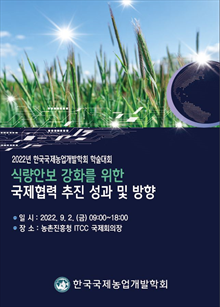간행물
한국국제농업개발학회 학술대회

- 발행기관 한국국제농업개발학회
- 자료유형 학술대회
- 간기 연간
- 수록기간 2013 ~ 2022
- 주제분류 농수해양 > 농학 농수해양 분류의 다른 간행물
- 십진분류KDC 522DDC 630
권호리스트/논문검색
2022 한국국제농업개발학회 학술대회 (2022년 9월) 22건
21.
2022.09
구독 인증기관·개인회원 무료
케냐의 축산업과 양계산업은 국내총생산의 9%와 2% 수준이다. 2016년에서 2020 년 기간 동안 연평균 닭 사육 마릿수는 5,100만수, 계란생산량은 92,700톤 정도이 다(FAO stat). 케냐에서는 닭고기와 계란 생산성이 높으면서 각종 병해에 강한 개 량된 토종닭이 주로 사육되고 있으며, 사육하는 가금류 중에서 토종닭이 차지하는 비중은 70~80% 수준으로 추산된다. 토종닭은 농촌지역과 도시근교에서 농가당 10~20마리 정도 사육되고, 여성과 어린아이들이 사육을 담당하는 경우가 많다. 토 종닭과 계란은 상대적으로 저렴한 동물성 단백질 공급원이자 농가의 소득원으로 영양결핍 또는 기아상태 개선에 이바지할 수 있다. 그러나 사양 및 질병 관리기술 미흡, 열악한 사양환경, 수입의존도가 높고 값비싼 사료, 불충분한 기술교육 등으 로 생산성이 낮은 실정이다. KOPIA케냐센터는 케냐 메루주(Meru County)에서 양 계 생산성 향상과 농가소득 증대를 위해 2020년부터 시범마을 사업을 추진하고 있다. Ng’onyi, Ntalami, Kangeta, Mbaria마을 400여 소농들이 참여하는 사업으로, 우량 병아리 공급, 시판사료 대비 저렴하면서도 품질은 더 높거나 대등한 자가 사 료제조기술 전수 등을 수행하고 있다. 본 연구에서는 사업참여농가 80호와 관행농 가 20호의 2020년 및 2021년 경영성과를 바탕으로 사업효과를 분석하였다. 관행농 가의 농가당 사육수는 2020년 16수, 2021년 19수였고, 사업참여농가는 2020년 56 수, 2021년 81수였다. 분석 결과, 백신접종 및 질병관리, 자가제조 사료 급여 등 사양기술 전수, 양계장 시설 개선 등을 통해 사업참여농가의 계란 생산량과 소득 이 관행농가에 비해 전반적으로 높아진 것으로 나타났다. 세부 결과는 다음과 같 다. 첫째, 관행농가에 비해 사업참여농가의 한 마리당 소득이 2020년에는 3.6%, 2021년에는 22.5% 높은 것으로 나타났다. 사양기술 습득효과로 사업참여농가의 한 마리당 계란생산량이 관행농가에 비해 2020년에는 13.4%, 2021년에는 19.7% 정도 많았기 때문이다. 둘째, 사육환경개선으로 사업참여농가의 닭 사육수가 증가하여 농가당 소득수준은 크게 증대하였다. 자가소비용 토종닭 사육으로부터 소득창출용 생산체계를 갖춰나가고 있다. 셋째, 관행농가에 비해 사업참여농가간 생산량 및 소득수준의 편차가 컸다. Mbaria마을의 경우 계란생산량과 소득이 다른 시범마을 에 비해 50% 수준에 그친 것으로 나타났다. 농가의 기술수준과 기술수용능력을 반영하여 교육프로그램을 운영하고, 모니터링을 강화할 필요가 있다.
22.
2022.09
구독 인증기관·개인회원 무료
Aish Muhammad, Cho Gyoungrae, Iqbal Hussain, Kazim Ali, Muhammad Zeeshan, Saima Noor, Hina Hafeez, Shahid Hameed, Shahid Hameed, Cha Jaebeom, Waqas Ahmed Dogar
Potato is an important cash crop of Pakistan and widely cultivated in plains and mountains of Punjab. Khyber Pakhtun Khawa Gilgit Baltistan, on an area of 0.313 million hectares in summer, autumn and spring with an annual production of 07.9 million tons. In Pakistan potato yield is 25.2 tons per hectare, which is although above the world average but comparatively low as compare to the potential and other advance potato growing countries because of several reasons. Availability of healthy seeds and advance production technology are the major constraints to achieve the higher potato production goals. It is very alarming that in spite of good position in potato growing countries, we are unable to produce good quality seed. In Pakistan >01% quality seed is available against the seed demand around 0.5-0.7 million tons per annum and mostly depend upon the imported seed 15000-20000 tons per annum. Tissue culture industry has been a proven global technology in potato seed production, so it is dire need of the growing population and climatic change to adopt these modern technologies of potato production for sustainable and higher production and income to contribute potato growing farmers of Pakistan. It is possible with the commercial use of tissue culture and allied techniques as aeroponic potato seed production along with good management and plant protection measures to provide indigenous high vigor and high yield potential potato seed. Pakistan Agricultural Research Council has established Aeroponic Potato Seed Production facility at National Agricultural Research Center with the collaboration of Korean Govt RDA-KOPIA Pakistan. The Aeroponics is a modern technology for growing plants by providing a nutrient solution in the air without soil. Plants grow rapidly in the growth chamber under the aseptic environment, balanced nutrition and sufficient oxygen availability that improves potatoes production in the aeroponic system. This can produce 10 times more yield than conventional production systems. Aeroponics techniques are credited for making potato yield more efficient, and can reduce the number of steps in the potato seed multiplication. Through tissue culture and aeroponics facilities development in Pakistan, first ever more than 200,000 nucleus mini harvested at NARC from the autumn 2021 and spring 2022 planation at KOPIA screen houses. Further seed multiplication from the harvest is under progress at up hills and more than 500,000 tubers (G1) are expected to be harvested during October-November 2022. It is very encouraging, impressive and successful venture of KOPIA at Pakistan for the potato seed production and self-sufficiency to insure food security in the country.
1
2

